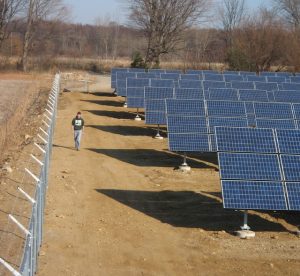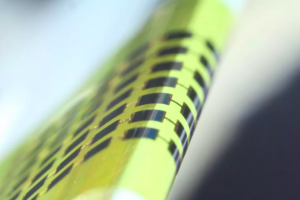Solar photovoltaic (PV) technology will change the way humanity views power. It differs from other energy sources in one crucial way: it doesn’t generate power at one specific location, it’s accessible for harvest anywhere and anytime the sun hits.
Solar technology that we have right now is done in industrial scale. It uses fields of mirrors to focus sunlight and heat up a thermal fluid, where heat is then passed through an exchanger to produce steam that is used in a turbine to produce electricity. However, this so-called “solar farm” requires a tremendous amount of energy to build and maintain, is an incredibly pervasive feature, and the resulting power is not distributed evenly.

Fields of solar panels
Now imagine a world where power generation is completely integrated into the fabric of society, in infrastructure, transportation, clothes, and even our skin. This is possible when PV technology is highly diffused and scalable to our specific needs. Current research in this field achieved just that.
Back in February 2016, researchers at the Massachusetts Institute of Technology (MIT) created the lightest, thinnest solar cells ever produced. It is so lightweight that they could drape a working cell atop a soap bubble, without popping it. According to Vladimir Bulović, MIT’s associate dean for innovation, the key is to make all the components in a single process: “The innovative step is the realization that you can grow the substrate at the same time you grow the device.”

Placing PV Cell atop a soap bubble. Photo: Joel Jean and Anna Osherov (MIT)
Unlike industrial-scale PV manufacturing, this new process takes place in a temperature-controlled vacuum chamber without the use of harsh chemicals, and components of the solar cell are “grown” by chemical vapor deposition technique. Chemical engineering professor, Karen Gleason, said that this process is akin to soot deposit from a light source. It can be tuned to accommodate more delicate materials, such as organic polymers. This allows researchers to deposit the PV cells on just about any material. Similar models were tested on multiple surfaces and a team of scientists in South Korea have made one flexible enough to bend around a pencil tip (Applied Physics Letter). PV cells will no longer be restricted to rigid crystalline silicon mega-structures.

Flexible, ultra-thin solar cells wrapped around a 1mm-thick glass panel
However, efficiency needs to be considered. Will a micro-scale solar cell be powerful enough to satisfy energy needs? Results concluded that these ultra-thin PV modules has the highest power-to-weight ratio ever created, about 400 times higher than a conventional solar cell, their lack in energy density is balanced out by their ubiquity.
Following this trajectory in PV research, solar energy can and will be more integrated and omnipresent. It might just alleviate the energy crisis, preventing monopoly, distributing it evenly to impoverished areas around the world.
